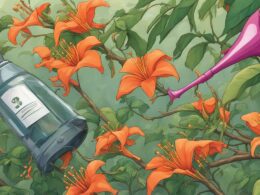Are you curious about the blooming cycle of dandelions? Look no further! In this article, we’ll explore the fascinating flowering cycle of dandelions and provide you with all the information you need. So, let’s dive in!
Dandelions bloom from May to October, with the peak season occurring in May and June. While many factors influence their flowering, a period of low temperature intensifies their blooming. Interestingly, unlike some other plants, daylength does not have a significant influence on dandelion flowering.
Seedlings that emerge in the spring may even flower in their very first year, adding to the beauty of your lawn or garden. Additionally, established dandelion plants that bloom in the spring can surprise you with another round of vibrant flowers in the autumn.
The time from flowering to seed ripening is relatively short, taking about 9 to 12 days. What’s even more astonishing is that each dandelion flower head can produce up to 400 seeds, with an average of 180 seeds. These wind-dispersed seeds can travel great distances—up to 500 meters from the parent plant—ensuring the widespread presence of dandelions.
But that’s not all! Dandelions are persistent fighters in the plant kingdom. Individual plants can survive for 10 to 13 years in undisturbed sites, thanks to their ability to form a relatively persistent seedbank. So, even when you think you’ve defeated them, these resilient plants can make a comeback.
Now that you know more about when dandelions bloom and their fascinating flowering cycle, you can appreciate the beauty and resilience of these iconic plants. Stay tuned for the next sections of this article, where we’ll further explore the biology of dandelions and effective management strategies to control their growth.
Biology of Dandelions
When it comes to dandelions, understanding their biology is key to effectively managing them. These perennial weeds have a stout taproot that allows them to withstand harsh conditions, such as drought. Dandelions flower from May to October, with flowering intensifying in low temperatures.
What’s fascinating is that seedlings can actually flower in their very first year. Not only that, established dandelion plants that bloom in spring have the ability to produce a second round of flowers in autumn. The time it takes for dandelion flowers to ripen into seeds is approximately 9-12 days.
A single dandelion flower head has the potential to produce up to 400 seeds, with an average of 180 seeds. These seeds play a crucial role in the dandelion’s life cycle, ensuring their propagation. Germination of ripe dandelion seeds is stimulated by light, nitrate, and alternating temperatures.
Seedlings mainly emerge from March to October, with a flush of seedlings appearing in March and April. However, dandelions are not only dependent on seed production for reproduction. They also have a fleshy taproot that allows them to reproduce vegetatively from pieces of the taproot.
As wind-dispersed plants, dandelions can spread their seeds up to 500 meters away from the parent plant. This long-distance dispersal mechanism helps them colonize new areas and ensures their persistence. Now that you have an understanding of the biology of dandelions, let’s explore effective management strategies in the next section.
Dandelion Biology Highlights:
- Dandelions are perennial weeds with a stout taproot.
- They flower from May to October, with low temperatures intensifying flowering.
- Seedlings can flower in their first year, and established plants that bloom in spring can also flower again in autumn.
- From flowering to seed ripening takes about 9-12 days.
- Dandelion plants can produce up to 400 seeds per flower head, with an average of 180 seeds.
- Germination of ripe seed is stimulated by light, nitrate, and alternating temperatures.
- Dandelions have a fleshy taproot that allows them to survive drought and easily regrow.
- They can reproduce vegetatively from pieces of the taproot.
- Dandelions are wind-dispersed, with their seeds able to travel up to 500 meters from the parent plant.
Dandelion Management
Dandelions can be challenging to control due to their deep taproot and ability to regenerate from root fragments. To effectively manage dandelions, it is essential to prevent flowering and seeding. Here are some strategies to tackle dandelion control and weed management:
- Hand-pulling: Although time-consuming, hand-pulling can be an effective way to eliminate dandelions. Ensure you remove the entire taproot to prevent regrowth.
- Mowing: Mowing your lawn may provide temporary control by cutting off the dandelion flowers. However, it may not be sufficient to completely eradicate the weeds.
- Herbicides: One of the most common methods for dandelion control is using herbicides. When dandelions are actively growing, herbicides like 2,4-D, dicamba, and MCPP can be effective in eliminating them. It is important to follow the instructions on the herbicide product carefully.
- Spot treatment: Instead of broadcast treatments, spot treating individual plants with herbicides can often yield better results. This targeted approach ensures that the herbicide is directly applied to the dandelion, minimizing damage to surrounding vegetation.
- Timing: Late summer and early fall are ideal times to control dandelions as they are actively growing and preparing for the winter. However, spring applications of herbicides can also have some impact on dandelion management.
It’s important to note that broadleaf weed killers containing glyphosate are not recommended for dandelion control, as they may not effectively kill the root. To ensure successful dandelion management, a combination of methods may be necessary, tailored to your specific situation.
Conclusion
In summary, dandelions are known for their vibrant bloom, with the peak season occurring in May and June. They produce a large number of seeds and have a persistent seedbank, making them resilient and capable of spreading quickly. Managing dandelions can be challenging due to their deep taproot and ability to regenerate from root fragments.
To effectively control dandelions, it is important to prevent flowering and seeding. Regularly hand-pull the plants to remove them from your lawn or garden. Mowing can provide temporary control but may not completely eradicate the problem. Utilizing herbicides, such as 2,4-D, dicamba, and MCPP, can be an effective solution when dandelions are actively growing.
For optimal results, focus on dandelion management during late summer and early fall. However, applying herbicides in the spring can also have some impact. Understanding the biology and life cycle of dandelions is crucial in implementing successful management strategies that keep these stubborn weeds at bay.
Do Dandelions and Snake Plants Bloom at the Same Time of Year?
Yes, dandelions and snake plants do not bloom at the same time of year. Dandelions typically bloom in the spring, while snake plants bloom very rarely and usually indoors. For more snake plant blooms information, it’s best to consult a horticulturist or gardening guide.










